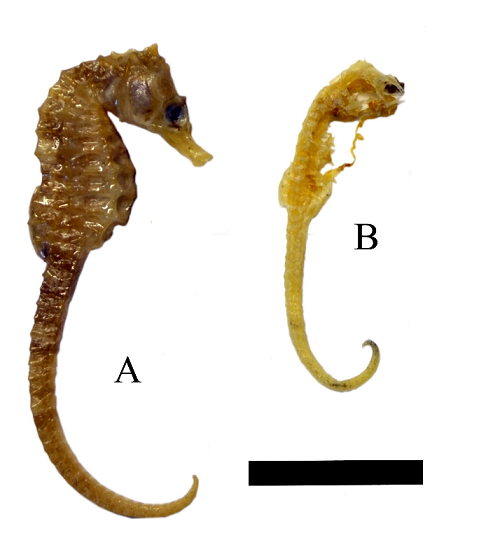Unusual record of a multiple predation of the Patagonian seahorse Hippocampus patagonicus by the Narrownose smooth-hound Mustelus schmitti in Argentine coastal waters
DOI:
https://doi.org/10.47193/mafis.3422021010604Keywords:
Crypsis, diet, ‘El Rincón’, Syngnathidae, TriakidaeAbstract
Seahorses (Genus Hippocampus) are rarely reported as prey items. Their low population numbers, their ability to blend with the environment and their low palatability are the features making them an unsuitable option for predators. Five individuals of the Patagonian seahorse Hippocampus patagonicus were found in the stomach of a single narrownose smooth-hound shark Mustelus schmitti from a sample of 959 stomachs analyzed. This rare record in a single stomach out of hundreds analyzed suggests that these individuals might have clustered in a group which was detected by the opportunistic M. schmitti.
Downloads
References
Belleggia M. 2012. Ecología trófica del gatuzo, Mustelus schmitti (Springer, 1939) en el Mar Argentino [PhD thesis]. Mar del Plata: Facultad de Ciencias Exactas y Naturales, Universidad Nacional de Mar del Plata. 228 p.
Belleggia M, Figueroa DE, Bremec C. 2014. The dentition of the narrownose smooth-hound shark, Mustelus schmitti. Mar Fresh Res. 65: 688-696.
Belleggia M, Figueroa DE, Sánchez F, Bremec C. 2012. The feeding ecology of Mustelus schmitti in the southwestern Atlantic: geographic variations and dietary shifts. Environ Biol Fish. 95: 99-114.
Chiaramonte GE, Pettovello AD. 2000. The biology of Mustelus schmitti in southern Patagonia, Argentina. J Fish Biol. 57: 930-942.
Colonello JH, Christiansen EH, Macchi GL. 2011. Escala de madurez sexual para peces cartilaginosos de la Plataforma Continental Argentina. In: Wöhler OC, Cedrola P, Cousseau MB, editors. Contribuciones sobre biología, pesca y comercialización de tiburones en la Argentina. Aportes para la elaboración del Plan de Acción Nacional. Buenos Aires: Consejo Federal Pesquero. p. 115-128.
Cortés E. 1997. A critical review of methods of studying fish feeding based on analysis of stomach contents: application to elasmobranch fishes. Can J Fish Aquat Sci. 54: 726-738.
Estalles ML, Pujol MG, Sánchez NE, Díaz de Astarloa JM, Luzzatto DC. 2017. The presence of the Patagonian seahorse Hippocampus patagonicus Piacentino and Luzzatto, 2004 (Teleostei: Syngnatidae) in Monte Hermoso, southwestern Buenos Aires province, Argentina. Check List. 13: 2065.
Foster S, Vincent ACJ. 2004. Life history and ecology of seahorses: implications for conservation and management. J Fish Biol. 65: 1-61.
Kleiber D, Blight LK, Caldwell IR, Vincent ACJ. 2011. The importance of seahorses and pipefishes in the diet of marine animals. Rev Fish Biol Fish. 21: 205-223.
Luzzatto DC, Estalles ML, Díaz de Astarloa JM. 2013. Rafting seahorses: The presence of juvenile Hippocampus patagonicus in floating debris. J Fish Biol. 83: 677-681.
Luzzatto DC, Pujol MG, Figueroa D, Díaz de Astarloa JM. 2014. The presence of the seahorse Hippocampus patagonicus in deep waters: additional evidence of the dispersive capacity of the species. Mar Biod Rec. 7: 1-2.
Luzzatto DC, Sieira R, Pujol MG, Díaz de Astarloa JM. 2012. The presence of the seahorse Hippocampus patagonicus in the Argentine Sea based on the Cytochrome b sequence of mitochondrial DNA. Cybium. 36: 329-333.
Piacentino GLM, Luzzatto DC. 2004. Hippocampus patagonicus sp. nov., nuevo caballito de mar para la Argentina (Pisces, Syngnathiformes). Rev Mus Arg Cienc Nat ns. 6: 339-349.
Pinkas LM, Oliphant S, Iverson ILK. 1971. Food habits of albacore, blue fin tuna and bonito in Californian waters. Cal Dep Fish Game. 152: 1-105.
Pollom R, Barreto R, Charvet P, Chiaramonte GE, Cuevas JM, Herman K, Montealegre-Quijano S, Motta F, Paesch L, Rincon, G. 2020. Mustelus schmitti. The IUCN Red List of Threatened Species 2020: e.T60203A3092243.
Sánchez RP, Navarro G, Rozycki V. 2012. Estadísticas de la pesca marina en la Argentina. Evolución de los desembarques 1898-2010. 1st ed. Buenos Aires: Ministerio de Agricultura, Ganadería y Pesca de la Nación.
Silveira RB, Siccha-Ramirez R, Santos Silva JR, Oliveira C. 2014. Morphological and molecular evidence for the occurrence of three Hippocampus species (Teleostei: Syngnathidae) in Brazil. Zootaxa. 3861: 317-332. DOI: https://doi.org/10.11646/zootaxa.3861.4.2
Walker TI. 2005. Reproduction in fisheries science. In: Hamlett WC, editor. Reproductive biology and phylogeny of chondrichthyes: sharks, rays and chimaeras. Enfield: Science Publishers. p. 81-127.
Wei J, Estalles ML, Pollom R, Luzzatto DC. 2017. Hippocampus patagonicus. The IUCN Red List of Threatened Species 2017: e.T195100A54909767.
Wetherbee BM, Cortés E. 2004. Food consumption and feeding habits. In: Carrier JC, Musick JA, Heithaus MR, editors. Biology of sharks and their relatives. CRC Press. p. 225-246.

Published
Issue
Section
License
Copyright (c) 2021 Mauro Belleggia , María Gabriela Pujol, M.L. Estalles, Daniel E. Figueroa, Diego C. Luzzatto

This work is licensed under a Creative Commons Attribution-NonCommercial-ShareAlike 4.0 International License.
Authors of articles published in Marine and Fishery Sciences retain copyright on their articles, except for any third-party images and other materials added by Marine and Fishery Sciences, which are subject to copyright of their respective owners. Authors are therefore free to disseminate and re-publish their articles, subject to any requirements of third-party copyright owners and subject to the original publication being fully cited. Visitors may also download and forward articles subject to the citation requirements. The ability to copy, download, forward or otherwise distribute any materials is always subject to any copyright notices displayed. Copyright notices must be displayed prominently and may not be obliterated, deleted or hidden, totally or partially.
This journal offers authors an Open Access policy. Users are allowed to read, download, copy, distribute, print, search, or link to the full texts of the articles, or use them for any other legal purpose within the Creative Commons 4.0 license (BY-NC-SA), without asking prior permission from the publisher or the author. This is in accordance with the BOAI definition of Open Access.























